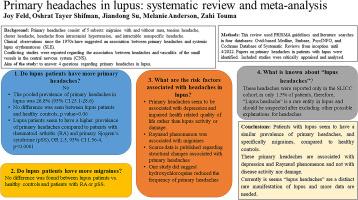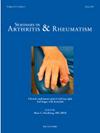Primary headache in SLE –systematic review and meta-analysis
IF 4.6
2区 医学
Q1 RHEUMATOLOGY
引用次数: 0
Abstract
Objectives
To systematically review and synthesize literature on: 1) the overall prevalence of primary headaches and specifically migraines, in patients with lupus since previous systematic review published in 2004; 2) the risk factors associated with primary headaches in patients with lupus; 3) the association of primary headaches with structural brain changes; and 4) “lupus headaches”.
Methods
This review used (Preferred Reporting Items for Systematic Reviews and Meta-Analyses) PRISMA guidelines and literature searches in four databases: Ovid-based Medline, Embase, PsycINFO, and Cochrane Database of Systematic Reviews from inception until 4/2022. Papers on primary headaches in patients with lupus were identified. Included studies were critically appraised and analyzed. Since a systematic review on this topic was published in 2004, only papers published in 2004 and later were included in this review. Statistical and publication bias was assessed using funnel plots.
Results
A total of 5096 references were identified, 189 were selected for detailed review and 11 papers were included in the final analysis. 1) The pooled prevalence of primary headaches in lupus was 26.8 % (95 %CI 25.1–28.6). The prevalence of primary headaches was similar between patients with lupus and healthy controls, odds ratio (OR) 2.14, 95 %CI 0.97–4.76, p value=0.06, however publication bias was significant according to the Egger test. Lupus patients seem to have a higher prevalence of primary headaches compared to patients with rheumatoid arthritis (RA) and primary Sjogren's syndrome (pSS), OR 2.5, 95 % CI 1.56–4, p < 0.0001. Regarding the prevalence of migraines specifically, no difference was found between patients with lupus compared to healthy controls and patients with RA or pSS. 2) Primary headaches seem to be associated with depression and impaired health related quality of life rather than lupus activity or damage. There is insufficient data to conclude whether specific lupus treatments affected primary headaches in lupus, however, one study did suggest hydroxychloroquine reduced the frequency of primary headaches. Raynaud phenomenon was associated with migraines. 3) One study which examined MRI scans of patients with lupus compared to healthy controls did suggest that larger gray matter volumes reduced the odds for headaches in general (OR 0.98, p = 0.048) and for migraines in particular (OR 0.95, p = 0.004), and larger white matter volumes increased the odds for migraine (OR 1.04, p = 0.007). However, these findings might reflect disease activity or damage, therefore further studies are required to clarify this issue. 4) The only study which specifically addressed the prevalence of “lupus headaches” is Hanly's study from 2013 of the SLICC cohort. In this large cohort, only 1.5 % of patients had "lupus headaches", as defined by SLE Disease Activity Index-2000 (SLEDAI-2 K). Therefore “Lupus headache” is a rare entity in SLE and should be suspected after excluding other possible explanations for headaches, especially when there is no known prior history of primary headaches.
Conclusions
Patients with lupus seem to have a similar prevalence of primary headaches, and specifically migraines, compared to healthy controls. These primary headaches are associated with depression and Raynaud phenomenon and not with disease activity nor damage. Scarce data is published regarding structural changes associated with primary headaches. Currently is seems “lupus headaches” are a distinct rare manifestation of lupus and more data are needed.

系统性红斑狼疮的原发性头痛--系统回顾和荟萃分析。
目的系统回顾并综合以下方面的文献资料1)自2004年发表系统综述以来狼疮患者原发性头痛(尤其是偏头痛)的总体发病率;2)狼疮患者原发性头痛的相关风险因素;3)原发性头痛与脑结构变化的关联;4)"狼疮头痛":本综述采用了(系统综述和元分析的首选报告项目)PRISMA 指南,并在四个数据库中进行了文献检索:从开始到 2022 年 4 月,在基于 Ovid 的 Medline、Embase、PsycINFO 和 Cochrane 系统综述数据库中进行文献检索。确定了有关狼疮患者原发性头痛的论文。对纳入的研究进行了严格的评估和分析。由于 2004 年曾发表过一篇关于该主题的系统综述,因此本综述仅纳入 2004 年及以后发表的论文。使用漏斗图评估了统计和发表偏倚:结果:共发现 5096 篇参考文献,其中 189 篇被选中进行详细审查,11 篇论文被纳入最终分析。1)狼疮原发性头痛的总患病率为26.8%(95%CI 25.1-28.6)。红斑狼疮患者和健康对照组的原发性头痛患病率相似,几率比(OR)为 2.14,95 %CI 为 0.97-4.76,P 值=0.06,但根据 Egger 检验,发表偏倚显著。与类风湿性关节炎(RA)和原发性Sjogren综合征(pSS)患者相比,红斑狼疮患者的原发性头痛发病率似乎更高,OR为2.5,95%CI为1.56-4,P <0.0001。具体到偏头痛的发病率,狼疮患者与健康对照组、RA 或 pSS 患者相比没有发现差异。2)原发性头痛似乎与抑郁和健康相关的生活质量受损有关,而不是与狼疮活动或损害有关。目前还没有足够的数据来断定特定的狼疮治疗方法是否会影响狼疮患者的原发性头痛,但有一项研究确实表明羟氯喹会降低原发性头痛的频率。雷诺现象与偏头痛有关。3)有一项研究对红斑狼疮患者的核磁共振扫描结果与健康对照组进行了比较,结果表明,灰质体积越大,患头痛的几率越低(OR 0.98,p = 0.048),尤其是偏头痛(OR 0.95,p = 0.004),而白质体积越大,患偏头痛的几率越高(OR 1.04,p = 0.007)。然而,这些发现可能反映了疾病的活动性或损害,因此需要进一步研究来澄清这一问题。4) 唯一一项专门针对 "狼疮性头痛 "患病率的研究是汉利在2013年对SLICC队列进行的研究。在这个庞大的队列中,根据系统性红斑狼疮疾病活动指数-2000(SLEDAI-2 K)的定义,只有1.5%的患者患有 "狼疮性头痛"。因此,"狼疮性头痛 "在系统性红斑狼疮中是一种罕见的病症,应在排除其他可能的头痛原因后再进行怀疑,尤其是在没有已知的原发性头痛病史的情况下:结论:与健康对照组相比,狼疮患者似乎有相似的原发性头痛,特别是偏头痛。这些原发性头痛与抑郁和雷诺现象有关,而与疾病活动或损害无关。与原发性头痛有关的结构变化方面的数据很少。目前看来,"狼疮头痛 "是狼疮的一种独特的罕见表现,还需要更多的数据。
本文章由计算机程序翻译,如有差异,请以英文原文为准。
求助全文
约1分钟内获得全文
求助全文
来源期刊
CiteScore
9.20
自引率
4.00%
发文量
176
审稿时长
46 days
期刊介绍:
Seminars in Arthritis and Rheumatism provides access to the highest-quality clinical, therapeutic and translational research about arthritis, rheumatology and musculoskeletal disorders that affect the joints and connective tissue. Each bimonthly issue includes articles giving you the latest diagnostic criteria, consensus statements, systematic reviews and meta-analyses as well as clinical and translational research studies. Read this journal for the latest groundbreaking research and to gain insights from scientists and clinicians on the management and treatment of musculoskeletal and autoimmune rheumatologic diseases. The journal is of interest to rheumatologists, orthopedic surgeons, internal medicine physicians, immunologists and specialists in bone and mineral metabolism.

 求助内容:
求助内容: 应助结果提醒方式:
应助结果提醒方式:


